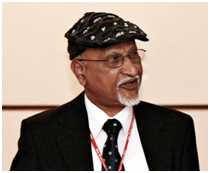| Biography | |
|---|---|
 Prof. Mukunda Das The Australian National University, Australia |
|
| Title: Mesoscopic Physics: Quantum Electronic Transport in Quasi- 1D Systems | |
| Abstract: Electronic transport in quasi-one dimensional (1-D) systems are mainly studied in quantum point contact (QPC) and quantum wire devices. It was first reported in QPCs of high electron mobility devices of GaAs/GaAlAsheterostructure, where steps of differential conductance (G normalized to a quantum value G0 = 2e2/h) was observed as a function of gate voltage. Since 1988 a number of other 1-D systems from Si metal-oxide field effect transistors, GaAs type other hetero-structures and constricted graphenes etc. exhibited the quantised steps. Apart from quantized steps of universal nature (having its occurrence at integral values n= 1, 2. 3 etc. for G/G0 = n) there seems to be anomalies observed in many of the above systems at the nonintegral values. Generally there are two types of anomalies. (i) Thomas and coworkers are first to identify an anomalous structure in the conductance below the first quantized step in GaAs QPCs at about 0.7(2e2/h). It has been argued that this (0.7 anomaly) is an intrinsic property caused by many-body effect, which appears to arise independent of the materials system. Although 0.7 anomaly has been discussed abundantly in the literature, a careful observation of conductance features in all the 1D conductors would reveal anomalies at various conductance values apart from at 0.7. They occur clearly at someelevated temperature and at nonzero magnetic fields.(ii) Another anomaly has been identified in the nonlinear transport regime at low temperatures as zero-bias peak in the differential conductance while sweeping the drain bias. It is called “zero-bias anomaly” (ZBA). Explanation of these anomalies are mainly by two ideas; (1) an assumption of spontaneous spin polarization (SSP) and (2) presence of a many-body state arising out of Kondo physics. In this talk we shall critically discuss experimental findings and present various theoretical methods to explain the observed anomalies (1).
(1) M. P. Das and F. Green, Conductance anomalies in quantum point contacts and 1D wires, Adv. Nat. Sc.: Nanosci. Nanotechnol. 8 023001 (2017). | |
| Biography:
Mukunda Das is Honorary Professor in Theoretical Physics. He is Fellow of American Physical Society, Institute of Physics (UK) and Australian Institute of Physics. His research interest concerns the fundamental aspects of condensed matter, which include Superconductivity, Vortex Matter, Bose-Einstein Condensation, Meso- and Nanoscopic Systems, Strongly Correlated Electrons, Density Functional Theory and Theory of Disordered States. He is also interested in the professional ethics, an important subject of philosophy. He has been member of Editorial Board of many International Journals, namely- J. Physics: Condensed Matter (IOP)(2002-12), GSTF J of Physics and Applications, ANS J of Nano Sc and Nanotech (IOP), Inter. J Condensed Matter, Advanced Materials and Superconductivity Research, Nova Sc., New York and others.
| |
